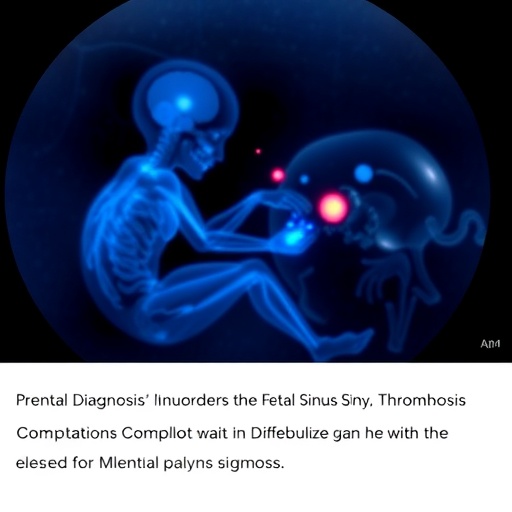In a groundbreaking study published in the esteemed journal Pediatr Radiol, researchers have pinpointed a rare yet critical condition known as fetal left transverse venous sinus thrombosis, particularly when accompanied by intracranial hemorrhage. This condition is predominantly characterized by the blockage of a major vein responsible for draining blood from the fetus’s brain, leading to a cascade of complications that can be detrimental to fetal health. While cases of venous sinus thrombosis are acknowledged in the neonatal population, the prenatal identification of such occurrences remains exceptionally rare. Hence, the insights gleaned from the study not only provide clarity on the condition but also pave the way for improved prenatal screening and intervention strategies.
Intracranial hemorrhage in fetuses often raises immediate alarm bells, as it indicates bleeding within the cranial vault. The research team, led by M. Keven and colleagues, made headway in understanding how this condition may arise, often correlating it with other syndromes that lead to disruptions in normal blood flow. The scientists utilized advanced imaging techniques, including high-resolution ultrasound and magnetic resonance imaging (MRI), to obtain a clearer insight into the underlying pathophysiology of the condition. These imaging modalities not only confirmed the presence of thrombosis but also allowed for the comprehensive evaluation of associated structures and potential complications.
The study explored the intricate mechanics of venous drainage in fetuses, revealing that any disruption within this system can lead to severe consequences. For instance, the left transverse sinus plays a pivotal role in draining blood from the left cerebral hemisphere and is critical for maintaining intracranial pressure balance. A blockage in this vein can precipitate a rise in intracranial pressure, resulting in hemorrhage. Understanding the anatomic and physiologic features of this venous drainage system is crucial for medical professionals, as it can significantly alter the clinical management of effected pregnancies.
Through meticulous case studies, the authors delineated the imaging findings associated with fetal left transverse venous sinus thrombosis. Such findings were pivotal in differentiating this condition from other potential pathologies that might present similarly on imaging studies. The presence of abnormal blood flow, found through Doppler ultrasound assessments, often indicated an impending hemorrhagic event. Thus, early intervention and monitoring strategies were deemed essential, prioritizing the safety and health of both mother and fetus.
The researchers emphasized that despite the potentially grave implications of fetal left transverse venous sinus thrombosis, with timely intervention and a multidisciplinary approach, favorable outcomes can be achieved. The study included a cohort of affected pregnancies, emphasizing the critical role of obstetricians, pediatricians, and radiologists in instituting a thorough management protocol. Short-term outcomes of the pregnancies were monitored closely, revealing a significant variance in complications depending on the timing of diagnosis and intervention.
Additionally, ethical considerations in prenatal diagnosis were addressed within the study, recognizing the need for balancing informative diagnoses with the psychological implications for expectant parents. One challenge in managing such cases lies in providing supportive care and comprehensive counseling, especially when adverse outcomes are anticipated. The researchers argued that open communication between healthcare providers and parents is vital for navigating the complexities of prenatal care in cases of suspected fetal thrombosis and hemorrhage.
Attention was also drawn to the use of prenatal counseling sessions, where prospective parents are offered insight into potential outcomes based on imaging results. The researchers proposed that these sessions must not only be informative but also compassionate, allowing parents to understand the implications of fetal conditions without causing undue anguish. This consideration highlights the importance of a supportive healthcare environment that prioritizes both medical and emotional aspects of prenatal diagnosis.
As the research concluded, it became evident that consistency among radiologists and obstetricians in identifying venous anomalies is essential for improving diagnostic accuracy. The study advocates for standardized protocols in imaging and reporting, which would facilitate better comparisons across cases and bolster the collective understanding of such rare conditions. Creating a repository of cases that focuses on prenatal diagnosis of venous sinus thrombosis could aid in evolving clinical practice.
The implications of this research extend beyond individual cases, as it encourages further exploration into the risk factors and potential preventive measures that could be taken during pregnancy. Understanding environmental and genetic influences on fetal blood flow can shed light on why certain fetuses are predisposed to conditions like venous sinus thrombosis. Future studies will undoubtedly delve deeper into these pathways, seeking to elucidate the multifactorial nature of this complex condition.
Lastly, the research illuminates the necessity for ongoing medical education about fetal venous thrombosis among healthcare providers. As the field of prenatal imaging evolves, continuing education opportunities will be crucial in enhancing clinicians’ ability to recognize and manage such conditions, thus improving both prenatal outcomes and long-term developmental trajectories for affected individuals.
In sum, the findings presented by Keven and colleagues underscore the urgency of enhancing prenatal diagnostic techniques and the methodologies employed in managing rare conditions such as fetal left transverse venous sinus thrombosis. The implications of this work are vast, setting the stage for future advancements in this field and inspiring a re-evaluation of current practices surrounding prenatal imaging and intervention.
Subject of Research: Prenatal diagnosis of fetal left transverse venous sinus thrombosis with intracranial hemorrhage.
Article Title: Prenatal diagnosis of fetal left transverse venous sinus thrombosis with intracranial hemorrhage: imaging findings and short-term outcome.
Article References:
Keven, M., Yalınbaş, E., Bütün, Z. et al. Prenatal diagnosis of fetal left transverse venous sinus thrombosis with intracranial hemorrhage: imaging findings and short-term outcome. Pediatr Radiol (2025). https://doi.org/10.1007/s00247-025-06475-0
Image Credits: AI Generated
DOI: 10.1007/s00247-025-06475-0
Keywords: Fetal left transverse venous sinus thrombosis, prenatal diagnosis, intracranial hemorrhage, imaging findings, obstetrics, pediatric radiology.




